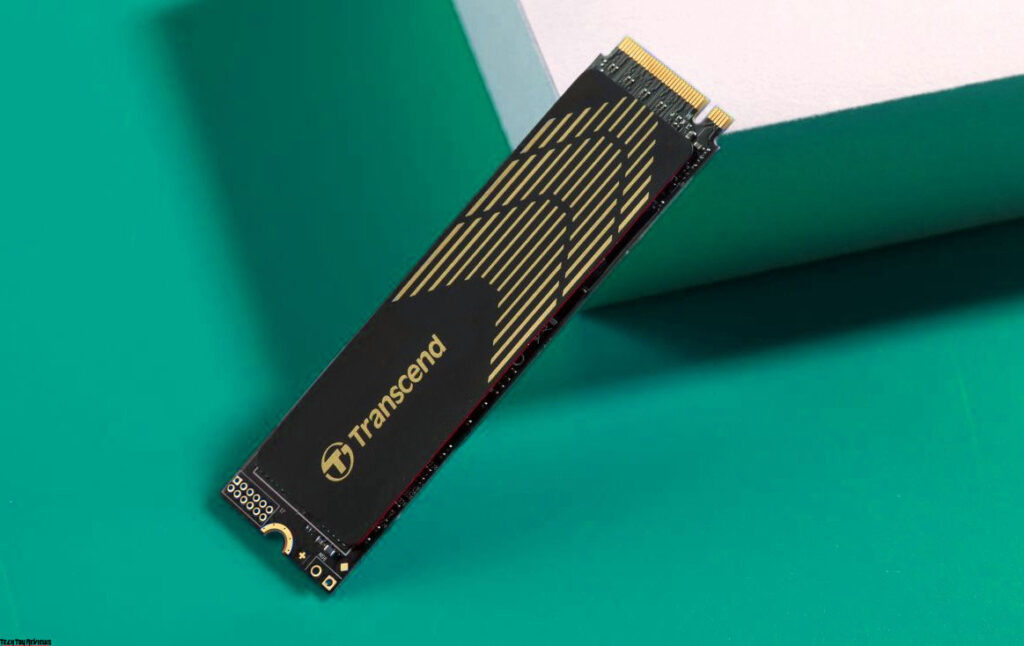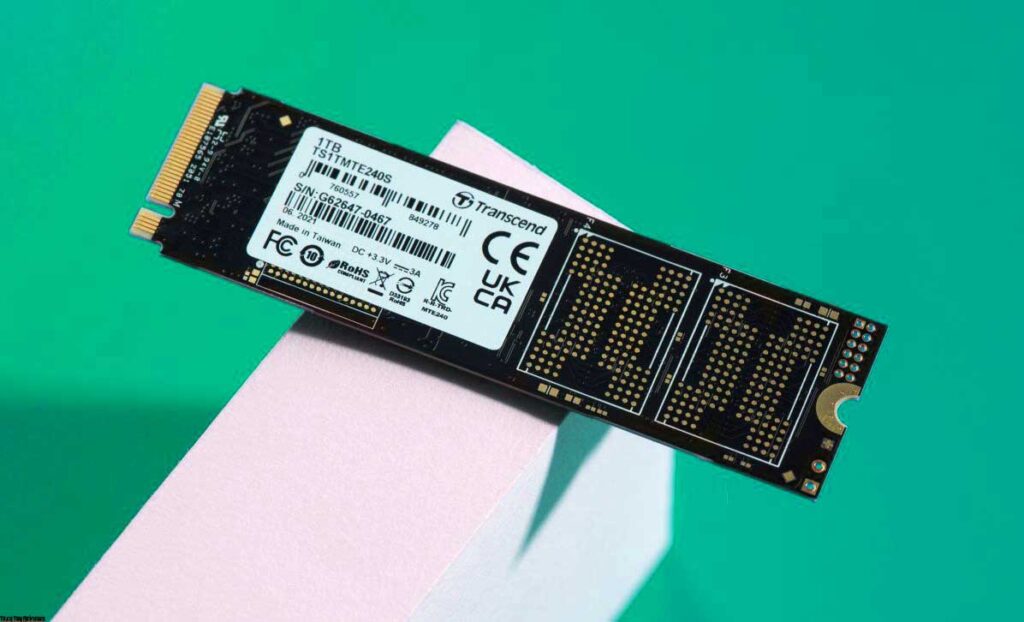Everyone knows that once using an internal SSD storage, it is impossible to use a regular HDD because everything seems to be slow. However, there’s another level to this thing: PCIe NVMe SSD drives. After them, even ordinary SSDs look slick. And this is the reason why we have brought this Transcend MTE240S review today.

Probably everyone already knows about NVMe, but it is not a sin to remind. When SSDs first appeared, they mimicked the form factor of hard drives. This was done for the sake of compatibility with the equipment, including the connection protocol from the HDD, that is, for the OS of those times, nothing really changed. The problem is that the SATA AHCI command set was designed with the physical characteristics of the hard drive in mind. In other words, it focused on a unit of rotating magnetic pancakes and nodding to read and write. These basics got in the way of flash memory. Therefore, modern SSD solutions have switched to the NVMe protocol, which is designed to transfer data to drives over flash memory. It connects not to the SATA connector, but to the PCI Express bus. In addition, on two or four lines at a time, which gives data transfer rates from 2 to 8 GB per second.
The Transcend MTE240S is a typical representative of modern PCI-Express SSDs that support the fourth revision of the high-speed bus. It is connected to the motherboard via 4 data lines, has onboard 3D-NAND memory and DRAM cache. According to all ratings, the new Transcend OS is a reliable option for installing games, software, and other similar things.
In this situation, users are interested in several questions: how fast do the memory and controller get used up, is the model hot, and how much does it cost?
What is inside
The semiconductor crisis is taking its toll on everything from the automotive industry to the PC components industry. SSDs are no exception. However, the Transcend MTE240S is built with the best components available in the market during this challenging time and is selling at a reasonable price.

The vendor used a controller from the middle segment – the time-tested Silicon Motion SM2267, which supports DRAM cache and a large number of different memory chips. The Transcend SSD drive is packed with 512-gigabit 96-layer Micron B27B crystals. The modules do not surprise with record performance, but they are optimal in terms of price and performance ratio. The amount of cache memory is 1 gigabyte. For 0.5TB and 1TB drives, that’s enough.
There’s no full-size radiator in the kit, and you shouldn’t rely on heat dissipation by stock thin radiators with graphene coating. The drive’s controller is hot, so it doesn’t hurt to add extra cooling to the SSD.
Benchmark data
NVMe PCIe SSD test results were predictable, as Transcend engineers used a mid-range microcontroller. Until the cache runs out, it provides read and write speeds of the order of 3 Gb/s. Unfortunately, the firmware of the controller was not enriched by direct data recording in TLC format, so with a long copy of an array of information, the speed would drop twice. First, the DRAM buffer will run out, the SSD will start writing data directly to the memory chips. Next, the free SLC cells will be filled (usually there is about half the free space). Therefore, the drive will simultaneously overwrite the copied data in a “dense” format and design the storage of the new one.
It sounds scary, but in reality, you will only encounter this effect when transferring a Steam library. In real-life scenarios, performance is almost always limited by other factors: Internet speed, software performance, and so on.
We ran all the benchmarks in this Transcend MTE240S review three times in a row. For each case, the average result was taken and rounded to the nearest integer multiple of five. Tested on an AMD X570 platform with a Ryzen 9 5900X processor, however, on a computer with PCI-E 3.0, the performance should be the same (losses will not exceed 10%).
CrystalDisk Mark 8.0
- Sequential Reading: 128K, 8Q8T – 2850 MB / s
- Sequential Write: 128K, 8Q8T – 3215 MB / s
- Random access to read 4K blocks: 274 515 IOPS Q4Т8 / 19 320 IOPS Q1Т1
- Random access to write 4K blocks: 486 050 IOPS Q4Т8 / 60 005 IOPS Q1Т1
We did not change the methodology for testing the SSD in real conditions. The first step was to fill the Transcend MTE240S with 65% Steam Library cache to check for a possible drop in speed. Eventually, many budget models start out slow as free space runs out. Data were recorded in two ways: we copied one 50 GB file from another drive (PCIe 4.0 x4) and then moved 50 files of 1 GB each. The second SSD offers read and write speeds over 6,000 MB/s, so it wasn’t the limiting factor in our Transcend MTE240S review test.
Linear velocity test of large amounts of data
- Reading files: 50 GB single file: 2400 MB/s / 50 GB – 50 files: 2680 MB/s
- Writing files: 50 GB single file: 2235 MB/s / 50 GB – 50 files: 3195 MB/s
In the case of using the PCI-E 3.0 protocol, the performance of Transcend MTE240S will noticeably decrease (by about 1000 MB/s), but it will still be enough for everyday scenarios. If you need an SSD here and now, the new product will be good to work on the current hardware, but don’t expect records.
Best for Budget users
For SSD drives today, two factors are important: price and availability. If you don’t mind any QLC slags for Office PCs and older SATA solutions, you have two options to choose from. Take either an average modern model or take a closer look at the cheaper flagships of past years. The latter will offer both high-end memory and controllers with advanced firmware. The problem is that they are hardly available for sale.

Therefore, we can safely take a modern SSD from the 3D-NAND line with DRAM cache and use it. There are very few realistic scenarios in which this would prove to be a limiting factor. Well, those who need to read and write up to 7000 MB/s, most likely, choose a professional drive of a more expensive class.
Another interesting point is the endurance of the memory used. The 1 TB model has a TBW of 1,700 terabytes and an average time between failures (MTBF) of 5.5 million hours. It is 2.5 times more than the typical value for models in this price segment. That is, you do not have to worry about the wear and tear of the drive.
Final line
The Transcend MTE240S can be called a people’s drive. It doesn’t slow down in everyday tasks, withstands stress with the radiator well, and is protected by a five-year warranty. That is, the model will become obsolete more quickly than it would physically deteriorate. You can take it. So how did you like this Transcend MTE240S review? do tell us by commenting.
Price and availability
- 1TB model: $128.12 on Amazon or £141.01 on Amazon UK
- 500GB model: $133.99 on Amazon or £87.54 on Amazon UK
 Technology News, Reviews and Buying Guides review, monitor review, tablet review, laptop review, mobile review, smartphone review, buying guide,
Technology News, Reviews and Buying Guides review, monitor review, tablet review, laptop review, mobile review, smartphone review, buying guide,


